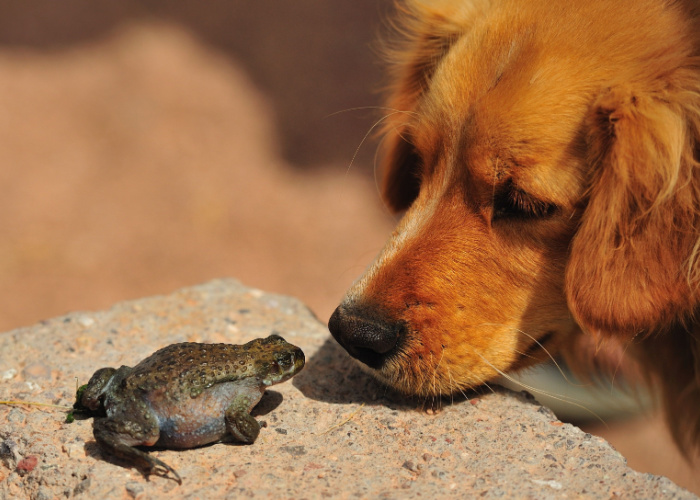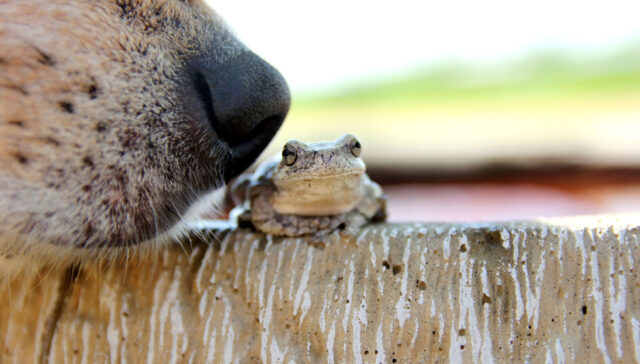
Table of Contents
I think my dog ate a frog. What do I do?
Did your woofer just come running up to you with a “chew toy’?
But when you bent down, you noticed him carrying a partly chewed frog in its jaws!
Ewww!
Our dogs can explore freely and come across a variety of creatures.
Unfortunately, they are curious and motivated by prey drives, so they may pull out frogs or toads and munch them.
We know it’s awful, but now is not the time to run away and let your dog wolf it down!
Could you identify whether it was a toad or a frog?
That might have been poisonous!
In today’s article, you’ll find out the urgent action you should take, the toxic toad/frog species, and how to stop your dog from eating them.
Let’s get started!
What Is The Difference Between Frogs and Toads?
Have no idea about the difference between a toad and a frog?
Although they are both amphibians from the order Anura, there are some ways to tell them apart.
Toads normally have shorter legs and rougher, thicker skin, whereas frogs often have long legs and slippery, mucus-covered skin.
You are more likely to find toads in your yard because frogs must dwell near water sources.
As a matter of fact, toads have few predators, but your playful canine companion can mistake it for danger.
Frogs or Toads – Which Is Poisonous?
Most frogs are not poisonous, but all toads are.
Toads emit poison from parotid glands in their neck and the area behind their eyes, releasing a creamy, thick, and white substance.
Depending on the species and their size, these deadly secretions typically contain one or more of the following toxins:
Toads usually expel these fluids when they perceive danger.
Mind you, frogs can still be dangerous even though there are more deadly species of toads.
If you’re still unsure whether it was a frog or a toad your dog accidentally ate, we suggest you keep reading this guide.
SUGGESTED READ: What You Need to Know About Poison Prevention for Dogs
My Dog Ate A Frog
If your dog ate a frog, how would you know?
You realize that without actually witnessing it, there's no way to tell if your woofer ate a frog, right?
You won't be able to tell if he throws them up unless you examine his stomach.
Frogs have a lot of bacteria on their skin, and their blood contains even more of them. These bacteria make them poisonous to dogs.
Have we mentioned that frogs also release a potentially deadly chemical through their skin?
These are the reasons why you should be ready by knowing some basic first aid.
What Happens If A Dog Eats A Frog?
Your dog's mouth and gums could experience a slight irritation.
In severe cases, Fido might experience toad poisoning.
When your dog tries to chew the toad, its skin releases a harsh taste and odor and can burn his eyes and nostrils.
One thing is for sure, your canine friend will not enjoy the taste of a frog or a toad and will spit them out.
Unfortunately, this will be too late if the frog or toad is toxic.
So, if your dog begins pawing excessively at its lips or eyes after playing outdoors, it might have come across a toad.
Toad venom is extremely harmful to woofers and can be fatal if left untreated.
What To Do If Your Dog Eats A Frog?
You should try to remove it from his mouth.
Remember: be calm so that taking the frog out of your furbaby's mouth doesn't cause any new problems.
Rinse his lips gently with water to remove any chemicals. Careful not to get him to inhale the water.
Important: do not force water down your dog's throat. It would simply transport the toxins deeper into his digestive system.
Instead, wipe his gums, tongue, and roof of the mouth with a wet cloth or towel.
Doing this will help remove some toxins before your dog's body absorbs them.
Toxins that frogs and toads emit tend to be sticky, so wiping out Fido's mouth could be a good way to lessen the effects of poisoning.
Then, if you can, take a sample of the frog and bring it to your vet.
Provide them with as much information as possible about your canine companion.
Note any symptoms your dog experience, along with when they first developed.
Additionally, you must inform your vet of any pre-existing problems your dog may have and any medications he may be on.
My Dog Licked A Frog
My dog didn’t eat it, but I saw him licking the frog. What do I do?
If your furbaby licked a toxic toad, you’d observe drooling and vomiting immediately–-usually within 30 minutes of contact.
This is because the toad fluids are highly irritating to your dog's mouth.
Note: your pooch can have more severe clinical symptoms if he already has heart issues.
Dr. Jarrod Butler claims that although cardiac symptoms have been seen to appear up to four hours after the incident, they may appear as early as 15 minutes afterward.
So, whether Fido licked or ate it, you should try to remove as much of the sticky substance as possible to prevent toxins from being absorbed.
Clean his mouth with a moist cloth for 1 to 20 minutes, washing it out after each wipe.
RELEVANT READ: Why Is My Puppy Vomiting: Causes and Treatments
My Dog Ate A Dead Frog
Unfortunately, a dead frog wouldn’t cause less danger.
Even if the frog or toad is not toxic, dead animals can harbor dangerous bacteria and parasites.
Parasites will benefit from the corpse's abundant nutrients (especially if the frog has been dead for some time).
When your furry buddy eats the dead frog, these parasites will enter his body and reside in his organs.
You should be aware of the following common parasites:
- Ringworm
- Tapeworms
- Whipworms
- Hookworms
- Roundworms
Remember that symptoms for parasites and poisoning can be similar, so you should rule out any other causes and speak with your vet.
SUGGESTED READ: 5 Best Flea Pills for Dogs to Protect Your Pet From Parasites
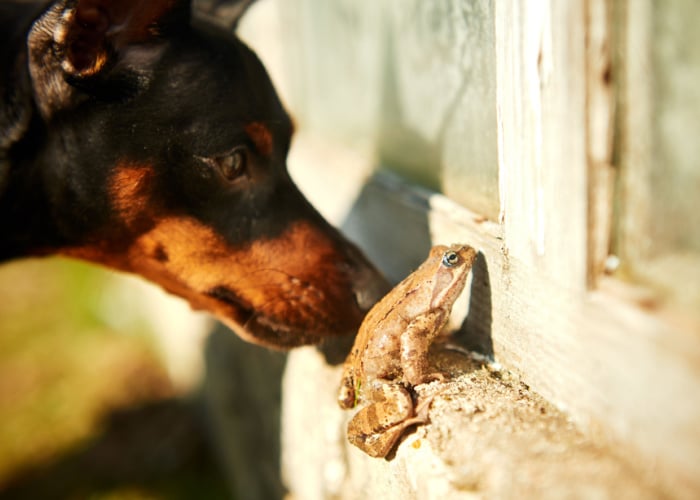
My Dog Ate A Frog – What Are The Symptoms
If your dog swallows or licks a frog or toad, he might froth at the mouth.
Does it mean my dog will die?
Contrary to what many people think, foaming is a natural cleansing process; it actually helps in removing toxins.
While your canine friend may not be in danger of dying, offering first aid right away is still crucial.
This will reduce the risk of your dog from severe poisoning.
The impact of the symptoms depends on the amount of toxins he has ingested.
Other signs to watch out for are:
- Shaking
- Collapse
- Looking dazed
- Bright red gums
- Excessive drooling
- Difficulty breathing
- Foaming at the mouth
- Abnormal heart rhythm
- Pawing at the face and mouth
- Rubbing mouth on different objects
RELATED: Why Is My Dog Foaming at the Mouth?
My Dog Ate A Frog – What Happens In Severe Cases?
If left untreated, the toad's poisons quickly enter your dog's circulation and attack the heart, neurological system, and blood vessels.
Your furry friend may experience any or all of the following in severe cases:
1. Weight Loss
We mentioned that vomiting and diarrhea are typical signs of your dog's body trying to rid itself of toxins.
By excreting these wastes too often, your four-legged pal also loses nutrients.
This loss of fluids and nutrients may affect Fido’s ability and desire to eat, resulting in appetite loss.
It can lead to weight loss and harm his health in the long run.
RELATED: How to Feed Underweight and Malnourished Dogs
2. Heart Problems
Frog and toad poisoning can cause irregular heartbeats or arrhythmias.
Arrhythmias can impair heart function and induce heart attack or organ failure.
This means that the heart may not be as resilient following an incident where the toxins were able to reach your dog’s bloodstream.
These poisoning incidents can induce early heart failure in dogs and are a leading cause of canine death.
RELATED: 4 Heart Problems in Dogs: Signs, Causes, and Treatments
3. Neurological Problems
One important question: Did you notice your furbaby experiencing tremors and seizures?
This is a usual sign of more serious issues with the nervous system.
These neurological issues can vary, but they usually have an effect on the spinal cord, brain, and nerves.
Depending on how bad it is, the toxin may permanently damage some of these organs or just do so temporarily.
So, pay attention if your woofer is acting dazed or unresponsive.
SUGGESTED READ: Seizures and Your Dog: Understanding the Different Types of Canine Seizures
Which Frogs or Toads Can Kill My Dog
Of course, you can only avoid the dangers when you know which toads are poisonous in your neighborhood.
If you don’t get answers from your neighbors, we suggest you conduct your own research specific to your area.
Even if a dead toad poses a threat of parasites and disease, poisonous frogs should be your #1 priority.
This list of the most toxic toads and frogs includes info on where they can be seen.
|
Frog/Toad |
Scientific Name |
Location |
| Cane/marine toad | Rhinella (formerly Bufo) marinus | North America: Texas, Florida, Louisiana, Hawaii, Mississippi) |
| Colorado River toad | Incillus (formerly Bufo) alvarius | North America: Southwest United States (New Mexico, southern California, Arizona, Colorado) and Mexico |
| Pickerel Frog | Rana (Lithobates) palustris | North America: Eastern United States (north to south: Maine to the Carolinas, Minnesota to Texas) |
Below are more details on the toxicity of some common toad species to people and dogs.
| Toad Species | Active Toxin | Highly Toxic to Dogs | Highly Toxic to Humans |
| American Toad | Bufotoxin | Yes | No |
| Gulf Coast Toad | Bufotoxin | Yes | No |
| European Green Toad | Bufotoxin | Yes | No |
| Fowler’s Toad | Bufotoxin | Yes | No |
| Western Toad | Bufotoxin | Yes | No |
| Asian Giant Toad | Bufotoxin | Yes | No |
| Asiatic Toad | Bufotoxin | Yes | No |
| Asian Common Toad | Bufotoxin | Yes | No |
| African Common Toad | Bufotoxin | Yes | No |
| Common Toad | Bufotalin Bufalitoxin Bufotoxin |
Yes | No |
| Japanese Common Toad | Bufatolin Bufotoxin |
Yes | No |
Pro tip from the author: You should put a collar bell on Fido to alert frogs (or other dangerous critters) to protect him from potential dangers.
I’ve done it not for this purpose but because our dog used to escape many times when he was younger.
But I guarantee this will work to keep those frogs away!
Just ensure it’s not too tight, loud, or heavy for him to handle.
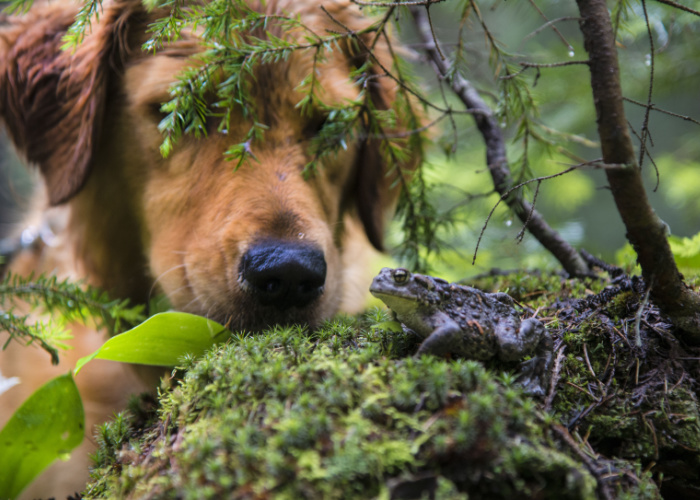
Are Frogs Poisonous To Dogs
Toads are dangerous for dogs.
Your furbaby's mouth can suffer even more serious damage from the deadly Cane toad and Colorado toad.
The majority of frogs and toads emit a chemical that can be toxic via their skin.
Your woofer absorbs these highly toxic chemicals through his mouth, nose, and eyes.
The bufagenin-containing toxin works similarly to cardiac glycosides like digoxins.
The glands contract and release toxins when your dog tries to bite or strike a frog.
How To Stop Your Dog From Eating Frogs
Limiting your dog's time outside is the easiest way to prevent such incidents.
Not that we advocate depriving them of outdoor adventure and access to nature.
Just be cautious and keep an eye on your canine companion as much as you can.
As a responsible parent, you should know the wildlife that usually lives in your area and close to your property.
It is most typical to encounter these different frogs and toads in the following conditions:
- Nighttime
- Around rainfall
- At dawn or dusk
- Summertime or high-humidity months
Most frogs are nocturnal, meaning they are more likely to hunt for food and be busy at night.
That said, raise your furbaby's food or drinking bowl off the ground at night, or better yet, don't leave them outside.
Toads may be attracted to them, increasing the chance of contact or contaminating your furbaby’s food.
My Dog Ate A Frog: FAQs
Is it okay for my dog to eat frogs?
If your dog comes into contact with the wrong kind of amphibian, it could be extremely toxic or even fatal if it doesn't get care right away.
Frogs may also be home to parasites that could harm your woofers. Your vet needs to be aware that your dog ate a frog.
Can dogs get rabies from eating frogs?
Since frogs are cold-blooded, they can not contract, carry, or spread the rabies virus to other animals.
The same holds true for other animals like fish, amphibians, and reptiles. The rabies-causing mammalian virus usually thrives in warm-blooded hosts.
How long does toad poisoning take in dogs?
Typically, toxic symptoms appear 30 to 60 minutes after contact.
Vomiting and diarrhea are frequent GI symptoms that become apparent immediately or within 15 minutes.
After exposure to the toxin, acute cardiac issues such as palpitations, hypertension, and tachycardia may appear within 15 minutes or 4 hours.
SUGGESTED READ: Congestive Heart Failure in Dogs: 10 Things You Should Do
Why is my dog's mouth foaming after eating a frog?
A milky liquid flows out when your dog bites a toad and squeezes the glands. Toxins often cause the mouth to foam.
However, toad poisoning from Colorado River toads and giant toads can result in serious symptoms, such as seizures, respiratory problems, and irregular heartbeats.
Can a dog recover from frog poisoning?
The good news is that most dogs that receive prompt treatment for toad poisoning recover.
If you treat your woofer for the most venomous toads in under a half-hour, his chances of recovering are good.
Can dogs get parasites from frogs?
When your dog consumes slugs, snails, or other creatures like frogs that have consumed slugs or snails, he may become infected with the Crenostoma vulpis parasite.
Dogs may accidentally eat these when they chew on grass, drink from puddles, or use outside water bowls.
RELEVANT READ: How Do I Know If My Dog Has Heartworms?
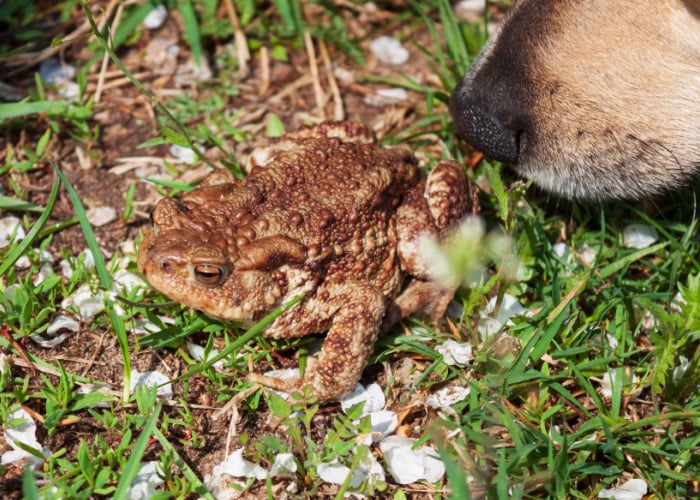
My Dog Ate A Frog: Takeaway
Frogs release poison from their skin to protect themselves from predators. Dogs that eat them—alive or dead—may be in danger.
If left untreated, toxic toads can kill our canine friends. Even the dead ones contain enough poison to harm them!
No matter what kind of frog or toad your woofer has licked or eaten, washing his mouth with water removes any lingering toxins.
If your dog's symptoms worsen and you notice him in pain, take him to the vet immediately.
And finally, find the right connections for toad removalists by contacting your local authority.
This way, Fido and other house pets can safely graze on the greenery in your yard.


